 "ttyymmnn" (ttyymmnn)
"ttyymmnn" (ttyymmnn)
07/10/2018 at 12:35 • Filed to: wingspan, Planelopnik, TDIAH
 4
4
 5
5
 "ttyymmnn" (ttyymmnn)
"ttyymmnn" (ttyymmnn)
07/10/2018 at 12:35 • Filed to: wingspan, Planelopnik, TDIAH |  4 4
|  5 5 |
!!! UNKNOWN CONTENT TYPE !!!
Welcome to
This Date in Aviation History
, getting of you caught up on milestones, important historical events and people in aviation from July 7 through July 10.
!!! UNKNOWN CONTENT TYPE !!!
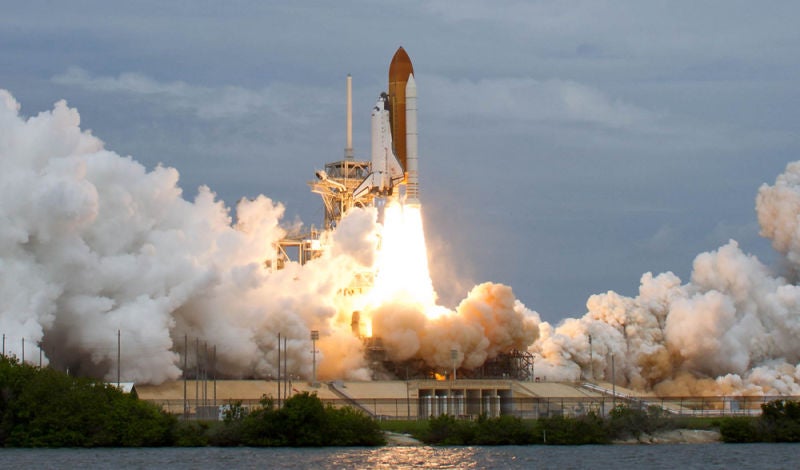
July 8, 2011 – The launch of the Space Shuttle Atlantis on STS-135, the final flight of the Space Shuttle program. Before the Space Shuttle !!!error: Indecipherable SUB-paragraph formatting!!! took its maiden flight on April 12, 1981, going into space had been the work of expendable spacecraft. Multi-stage rockets were left in orbit after their fuel was spent, or burned up re-entering the atmosphere, and the relatively tiny capsules that held the astronauts were so heavily damaged by the friction and heat of re-entry that they could not be used again. Since every component of the spacecraft had to be built from scratch for every launch, this was not only a wasteful way to get into space but also terribly expensive. Though we tend to think of the Space Shuttle as a product of the 1980s, NASA had already begun the process of developing a reusable spacecraft all the way back in 1969, the same year that !!!error: Indecipherable SUB-paragraph formatting!!! took his “one small step” on the Moon. They envisioned such a spacecraft essentially as a “space truck” that could haul payloads into space relatively cheaply and then be quickly used again.
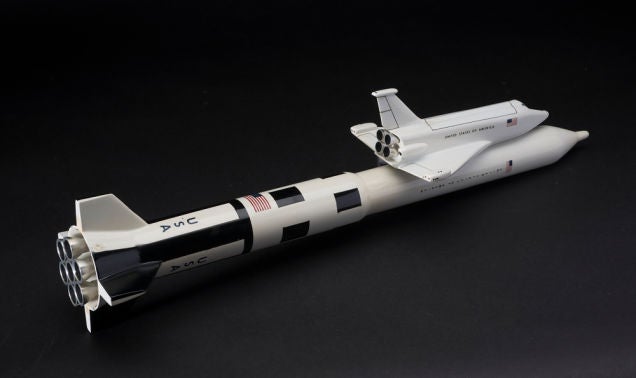 !!!CAPTION ERROR: MAY BE MULTI-LINE OR CONTAIN LINK!!!
!!!CAPTION ERROR: MAY BE MULTI-LINE OR CONTAIN LINK!!!
The !!!error: Indecipherable SUB-paragraph formatting!!! got its official start in 1972 with an announcement by President !!!error: Indecipherable SUB-paragraph formatting!!! that NASA would develop what later came to be called a Space Transport System (hence, all Shuttle missions were given the prefix “STS”). NASA considered many different concepts for the launch system and orbiter, and debated over just how much of the system would be reused. Engineers considered placing air-breathing engines on both the Shuttle and its booster, so both could be flown like an airplane during landing, or even flown between landing and launch sites. They also considered placing the Shuttle directly on top of an expendable launch rocket. Ultimately, NASA settled on a design where the orbiter was attached to a huge expendable fuel tank flanked by a pair of solid rocket boosters that would parachute into the ocean after launch to be used again. At the start of the program, the goals for the Shuttle were quite ambitious, and NASA hoped to preform as many as one launch per week. However, by the time the Shuttle was ready for launch, the realities of both the complex system and Congressional funding meant that the Shuttle never became the flying truck that NASA originally envisioned, though it did become NASA’s orbital workhorse during its thirty years of service.
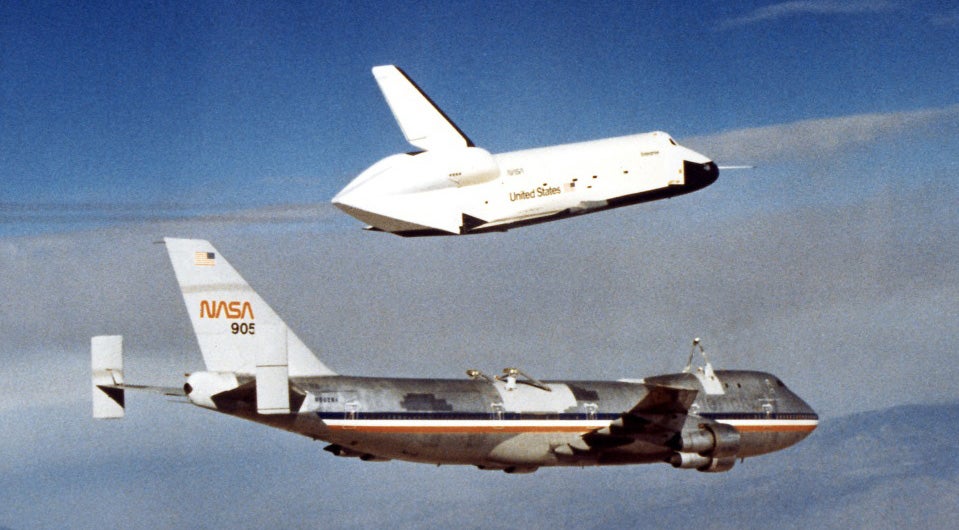
The first shuttle, Enterprise, separates from the Shuttle Carrier Aircraft for glide testing. An aerodynamic cone covers the rear engines. (NASA)
NASA built six Shuttles (the first, !!!error: Indecipherable SUB-paragraph formatting!!! , never went to space and was used for testing), and Shuttle fleet carried out hundreds of science experiments in the reusable !!!error: Indecipherable SUB-paragraph formatting!!! module carried in the Shuttle’s cargo bay and ultimately ferried 3,513,638 pounds of cargo into orbit. Shuttles were instrumental in the construction of the !!!error: Indecipherable SUB-paragraph formatting!!! (ISS), rotated crews between Earth and the Russian !!!error: Indecipherable SUB-paragraph formatting!!! space station and the ISS, and placed the !!!error: Indecipherable SUB-paragraph formatting!!! , along with many satellites, into both low and high Earth orbit. They also carried classified Department of Defense payloads into space. Over the thirty years of Shuttle service, orbiters circled the Earth 20,830 times and carried 355 astronauts (306 men, 49 women) from 16 different countries into space.
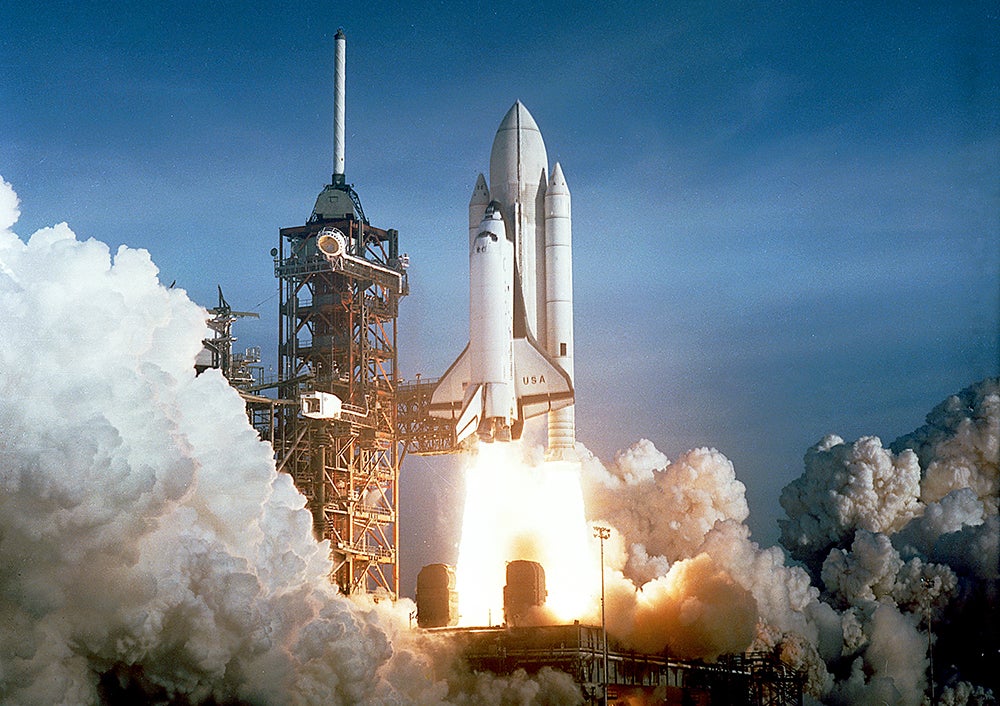
The Shuttle Columbia lifts off on STS-1, the first mission of the Space Shuttle program. (NASA)
Shuttle flights began on April 12, 1981 with STS-1, a manned flight that lasted just over two days. STS-135 was the 135th and final !!!error: Indecipherable SUB-paragraph formatting!!! of the Shuttle program. !!!error: Indecipherable SUB-paragraph formatting!!! lifted off from !!!error: Indecipherable SUB-paragraph formatting!!! and docked with the ISS on July 10. The mission was originally not scheduled to be flown due to a lack of funding, but NASA administrators stated the need to resupply to the ISS in light of delays in commercial rocket development and Congress eventually provided funding for the mission. The crew of four astronauts was the smallest since !!!error: Indecipherable SUB-paragraph formatting!!! in 1983, a necessity since there were no Shuttles available for a rescue mission should the need arise. If Atlantis were damaged during launch, the crew would have to stay at the ISS and return to Earth on regularly scheduled Russian !!!error: Indecipherable SUB-paragraph formatting!!! capsules, a process that would have taken a year.
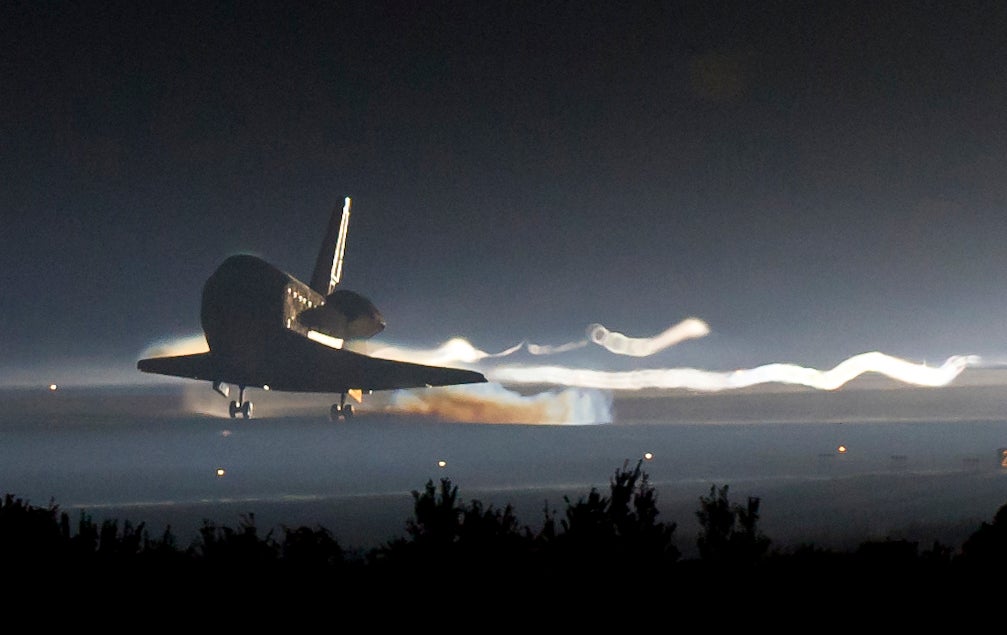
The Shuttle program comes to an end with a night landing at Kennedy Space Center in Florida, where it all began. (NASA)
With the end of the Shuttle Program, resupply missions to the ISS have been taken over by commercial space interests as part of NASA’s !!!error: Indecipherable SUB-paragraph formatting!!! program. All ISS crews will have to fly on Russian spacecraft until the completion of the !!!error: Indecipherable SUB-paragraph formatting!!! program to build a spacecraft capable of transporting crews into low Earth orbit. Over the span of Shuttle operations, the Challenger and Columbia were lost in flight along with a total of 14 astronauts. Following the end of the program, the remaining Space Shuttles were distributed to museums and display sites around the country. Atlantis is on display at the Kennedy Space Center Visitor Complex.
!!! UNKNOWN CONTENT TYPE !!!

(San Diego Air and Space Museum)
July 8, 1947 – The first flight of the Boeing 377 Stratocruiser. When the passenger airliner entered service before WWII, it was a relatively small aircraft by today’s standards, with room for only 10-15 passengers. But with the coming of WWII, strategic bombing missions called for aircraft that could carry large bomb loads, and the development of large piston-powered aircraft reached its zenith by the end of the war. When the war ended in August 1945, aircraft producers that had built bombers for the military took their expertise into the civilian sector, and the heavy bombers that had originally been designed for battle formed the basis of a new generation of large passenger airliners. The RAF had focused solely on the development of bombers during the war rather than transport aircraft, and the !!!error: Indecipherable SUB-paragraph formatting!!! and !!!error: Indecipherable SUB-paragraph formatting!!! were developed from the !!!error: Indecipherable SUB-paragraph formatting!!! bomber, while the !!!error: Indecipherable SUB-paragraph formatting!!! bomber formed the basis for the !!!error: Indecipherable SUB-paragraph formatting!!! . But England wasn’t the only country that took advantage of military aircraft conversions.
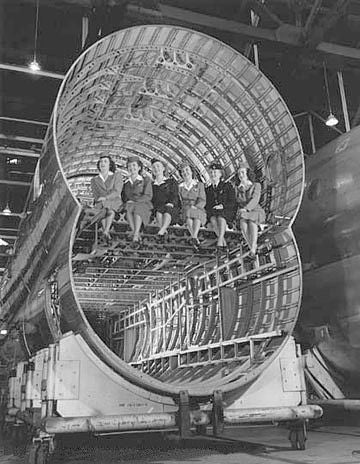
Flight attendants sit on the upper deck of the double-bubble fuselage in this Model 377 under construction. (Author unknown)
Boeing had been working on a large pressurized bomber since 1938, and when !!!error: Indecipherable SUB-paragraph formatting!!! entered service in 1944 it was by far the most technologically advanced four-engine bomber of its day. Designed to cross the vast reaches of the Pacific Ocean, the Superfortress had unparalleled range and power and carried enough fuel for flights of over 3,000 miles. Based on the success of the B-29, Boeing chose it as the basis for a large cargo aircraft, and work on the !!!error: Indecipherable SUB-paragraph formatting!!! began in 1942. They took the wings and lower fuselage from the Superfortress and added a second, enlarged fuselage tube on top, creating a double-bubble cross section with both an upper and lower deck. This enlarged aircraft now formed the basis for a civilian airliner which became known as the Model 377. While double-decker seating wasn’t necessarily an innovation (earlier large flying boats such as the !!!error: Indecipherable SUB-paragraph formatting!!! had two decks), the 377 was one of the first postwar land-based airliners to feature a lower seating area that accommodated 14 passengers in a lower deck lounge in addition 1oo passengers in upper deck seating. The top section was wider than competing airliners by Douglas, and the supercharged !!!error: Indecipherable SUB-paragraph formatting!!! engines provided a higher level of pressurization for the cabin passengers, as well as air conditioning.
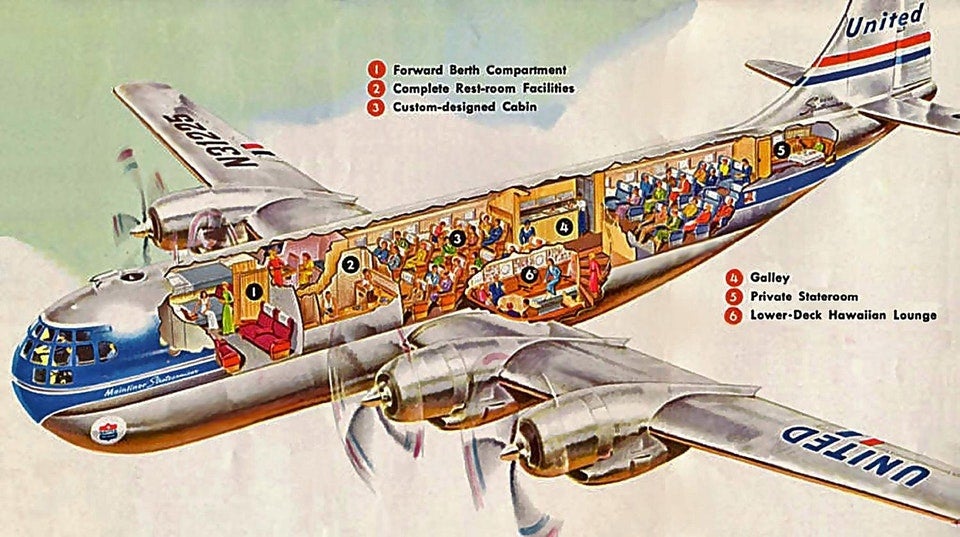
(Author unknown)
Pan Am was the launch customer for the 377 and ordered 20 Stratocruisers in 1945. The first passenger-carrying flight took place in April 1949 from San Francisco to Honolulu. For overnight flights, 28 passengers could be accommodated in berths that were more reminiscent of railroad !!!error: Indecipherable SUB-paragraph formatting!!! than airliners. By the sixth year of operation the 377 had carried over three million passengers, completed almost 3,600 transcontinental flights and crossed the Atlantic Ocean 27,000 times. As with other propeller-powered airliners, the 377 was eventually superseded by jet-powered airliners such as the !!!error: Indecipherable SUB-paragraph formatting!!! and !!!error: Indecipherable SUB-paragraph formatting!!! , and its last passenger flight was made in 1954. But the remarkable aircraft that started with the B-29 had yet one more conversion to make. Once its airliner days were over, the 377 served as the basis for the line of oversized !!!error: Indecipherable SUB-paragraph formatting!!! cargo carriers.
!!! UNKNOWN CONTENT TYPE !!!
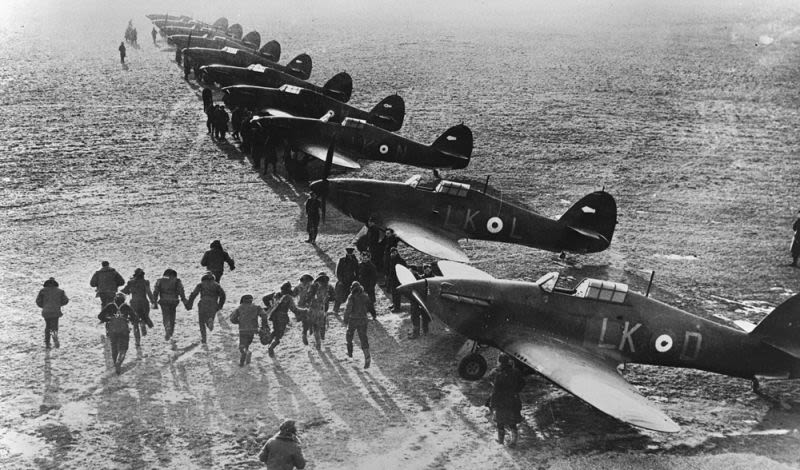
Pilots and crews from the Royal Canadian Air Force pilots scramble to their Hurricanes. (RCAF)
July 10, 1940 – The Battle of Britain begins. WWII in Europe started on September 1, 1939 with the German invasion of Poland. As German forces spread eastward and westward, France fell to the Nazis in the summer of 1940, and the situation was looking decidedly bleak for the British. The !!!error: Indecipherable SUB-paragraph formatting!!! fighting in France had been beaten back to the Channel coast at Dunkirk, and only through a truly heroic and herculean effort of the Royal Navy and British civilians were the soldiers !!!error: Indecipherable SUB-paragraph formatting!!! from the beaches. Though nearly 240,000 British, French and Belgian troops had been rescued, the Allies were on the run in Europe. On June 22, France officially signed an armistice with Germany, marking the end of the !!!error: Indecipherable SUB-paragraph formatting!!! . England was now alone to face the Germans in western Europe, and Adolf Hitler turned his sights on the island nation. He knew that as long as England stayed in the war he would not be able to claim complete victory over Europe, nor would he be able to turn his armies fully against Russia in the east. Hitler hoped that he might negotiate peace, but Britain was not interested. Despite the odds, they chose to fight, spurred on by the stirring words of Prime Minister !!!error: Indecipherable SUB-paragraph formatting!!! :
...The Battle of France is over. The battle of Britain is about to begin.... The whole fury and might of the enemy must very soon be turned on us. Hitler knows that he will have to break us in this island or lose the war. If we can stand up to him, all Europe may be free and the life of the world may move forward into broad, sunlit uplands. But if we fail, then the whole world...will sink into the abyss of a new Dark Age.... Let us therefore brace ourselves to our duties, and so bear ourselves that, if the British Empire and its Commonwealth last for a thousand years, men will still say, “This was their finest hour.”
With Britain resolved to defend their island, the Germans began planning for for a cross-channel invasion, known as !!!error: Indecipherable SUB-paragraph formatting!!! (Operation Sea Lion). But before such an invasion could take place, the Luftwaffe needed to achieve air superiority over the RAF. Luftwaffe Air Marshal !!!error: Indecipherable SUB-paragraph formatting!!! was certain that his forces could knock the RAF out of the sky while giving the !!!error: Indecipherable SUB-paragraph formatting!!! time to prepare for an invasion.
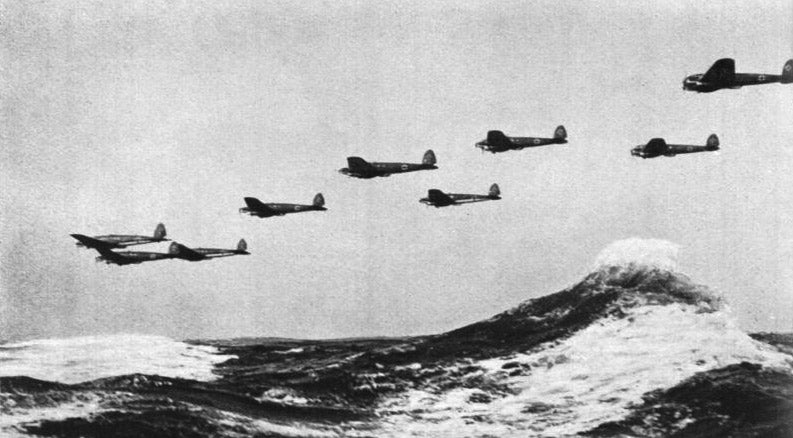
Luftwaffe Heinkel He-111 bombers fly low over the English Channel on their way to England. (Deutsches Bundesarchiv)
The Battle of Britain began on July 10, 1941 (German historians observe different operational dates), and while the battle came to be symbolized by the indiscriminate bombing of London, it opened with attacks against British shipping and ports. One month later, on August 13, the Luftwaffe launched !!!error: Indecipherable SUB-paragraph formatting!!! (Operation Eagle Attack), with three German Luftflotten (air fleets) unleashed against British air bases, radar installations and aircraft factories. Against this onslaught of 2,500 fighters and bombers, the RAF had about 600 fighters. But they weren’t just flown by British pilots. Commonwealth pilots from New Zealand, Australia, Canada, South Africa, Rhodesia (now Zimbabwe) fought, as wells pilots from Belgium, France, Poland and Czechoslovakia and a handful of pilots from neutral America and Ireland. The two main aircraft at the RAF’s disposal were the !!!error: Indecipherable SUB-paragraph formatting!!! and the newer !!!error: Indecipherable SUB-paragraph formatting!!! . Generally, the “Spit,” which was the more agile of the pair, tangled with the fighters, while the heavily armed “Hurries” took on the bombers. Both aircraft were superior to the !!!error: Indecipherable SUB-paragraph formatting!!! and !!!error: Indecipherable SUB-paragraph formatting!!! ranging over England. German !!!error: Indecipherable SUB-paragraph formatting!!! fighters were every bit the match for the British fighters, but long flights from the European continent left them low on fuel with little time to fight. The British also had the advantage of fighting over their home soil, where pilots could land quickly to re-arm and repair their fighters, and the defenders employed a network of coastal radar stations that warned Fighter Command of attacking waves of German planes.
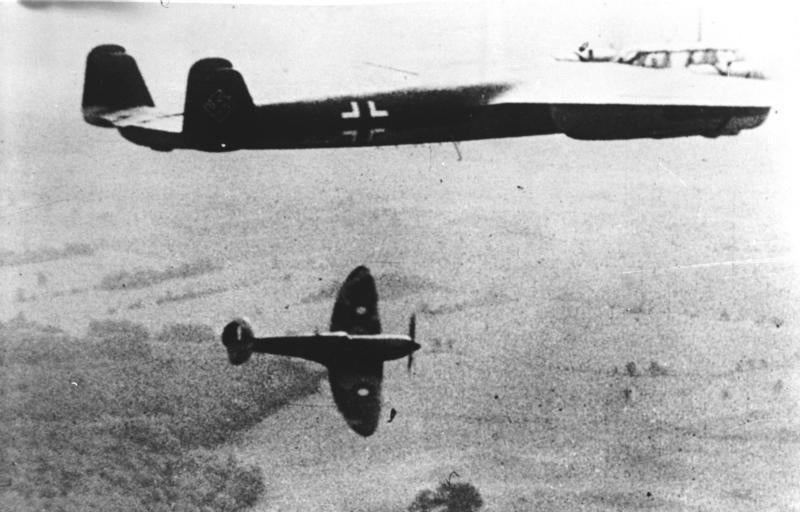
An RAF Spitfire harries a Luftwaffe Dornier Do-17 somewhere over England. (Deutsches Bundesarchiv)
By early September, Göring and his Luftwaffe were destroying British planes faster than they could be replaced, and the RAF teetered on the brink of annihilation. But when some German bombs accidentally fell on London, the British retaliated by bombing Berlin, and an outraged Hitler ordered Göring to shift his attacks from the RAF to London. This proved to be a fateful move. In what was known as !!!error: Indecipherable SUB-paragraph formatting!!! , German bombers rained their bombs down on British civilians, hoping to break British morale and force the government to the negotiating table. However, all the bombing did was strengthen British resolve to fight, and give the RAF the breathing room it so desperately needed to rest their air crews, rebuild their bases and replace their losses in planes and pilots. In what proved to be a stunning tactical blunder, the Blitz raids only continued to deplete the Luftwaffe while bringing them no closer to eliminating the RAF. As a result, Hitler pushed back the launch date for Operation Sea Lion, and eventually abandoned it altogether.
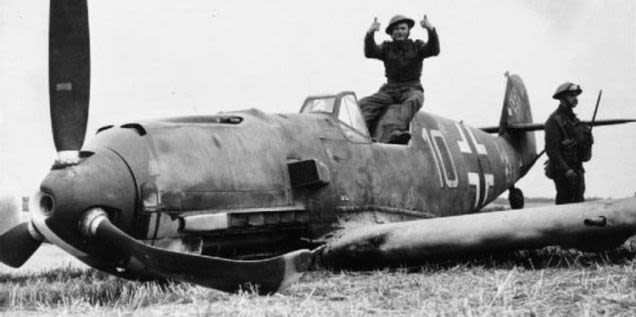
A jubilant British soldier sits in the cockpit of a downed Luftwaffe Bf-109. The thumbs up gesture was similar to Churchill’s famous V for victory. (Author unknown)
In a speech to Parliament on August 20, 1940, as the battle was drawing to a close, Winston Churchill praised the RAF for their effort and sacrifice to protect the British homeland:
The gratitude of every home in our Island, in our Empire, and indeed throughout the world, except in the abodes of the guilty, goes out to the British airmen who, undaunted by odds, unwearied in their constant challenge and mortal danger, are turning the tide of the World War..... Never in the field of human conflict was so much owed by so many to so few.
When the Battle of Britain finally ended on October 31, 1940, the RAF had lost 544 pilots against roughly 2,500 Luftwaffe pilots, and more than 40,000 British civilians had been killed. But England would not face the threat invasion again, and for the RAF, and all the defenders and citizens who withstood the German attack, it was indeed their finest hour.
!!! UNKNOWN CONTENT TYPE !!!
Short Takeoff
!!! UNKNOWN CONTENT TYPE !!!
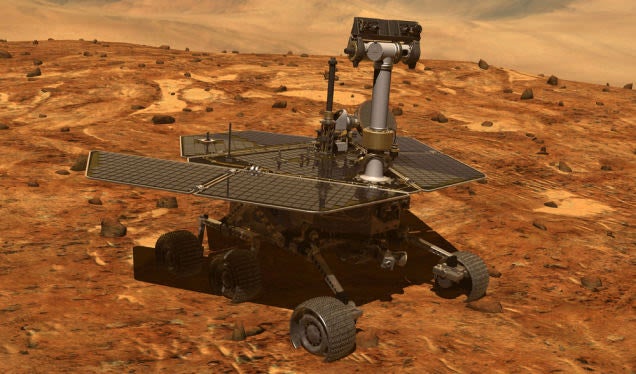
(NASA)
July 7, 2003 – The launch of Mars Exploration Rover–B, better known as Opportunity . Opportunity was launched atop a !!!error: Indecipherable SUB-paragraph formatting!!! rocket as part of NASA’s !!!error: Indecipherable SUB-paragraph formatting!!! program and landed on the Red Planet on January 25, 2004, three weeks after its sister rover !!!error: Indecipherable SUB-paragraph formatting!!! (MER-A). Spirit became mired in soft ground in 2009 and ceased communications the following year, but Opportunity continues to function 12 years after landing, even though it was designed to function for only 90 days. Opportunity has made significant discoveries on the geology of Mars, and has helped to determine whether the Earth’s closest neighbor was ever capable of sustaining life, looking particularly for signs of water. By January 2018, Opportunity had traversed over 28 miles of the Martian surface, surpassing the previous record for a rover set by the Russian !!!error: Indecipherable SUB-paragraph formatting!!! rover that landed on the Moon in 1973.
!!! UNKNOWN CONTENT TYPE !!!
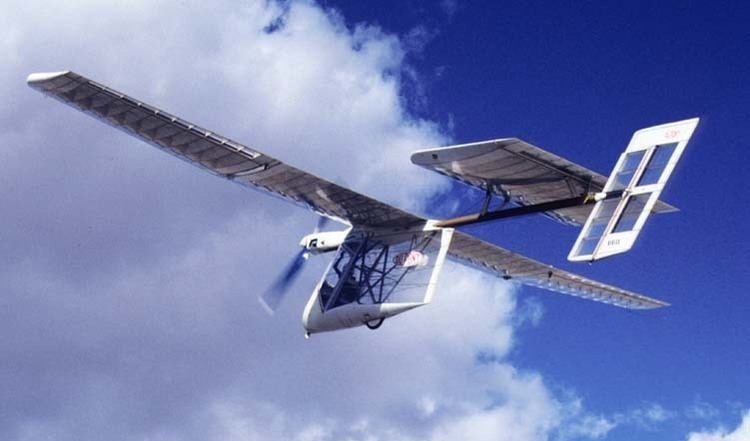
(Author unknown)
July 7, 1981 – The Solar Challenger completes the first solar-powered flight across the English Channel. Aeronautical engineer !!!error: Indecipherable SUB-paragraph formatting!!! had made a name for himself in the 1970s with human-powered aircraft, one of which, the !!!error: Indecipherable SUB-paragraph formatting!!! , was the first aircraft to cross the English Channel under human power in 1979. The Albatross was then developed into the !!!error: Indecipherable SUB-paragraph formatting!!! , which added a solar array to generate power for propulsion. The Solar Challenger was a much more robust development of the Penguin, with power for its two three-horsepower engines coming from 16,128 solar cells on the wings and horizontal stabilizer which provided up to 3,800 watts of electricity. The Solar Challenger took its maiden flight on November 6, 1980, and made the crossing of the English Channel from France to England in just under 5.5 hours. The aircraft is now part of the collection of the Smithsonian Air and Space Museum.
!!! UNKNOWN CONTENT TYPE !!!
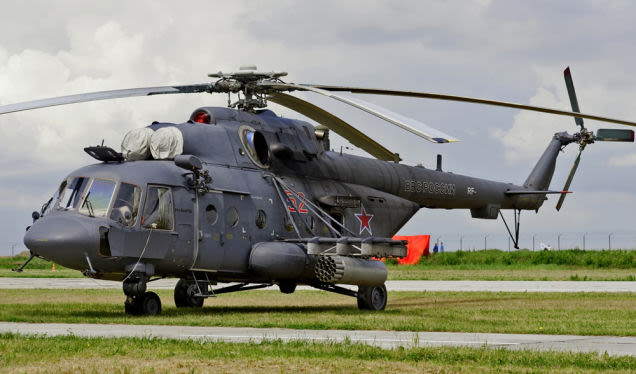 !!!CAPTION ERROR: MAY BE MULTI-LINE OR CONTAIN LINK!!!
!!!CAPTION ERROR: MAY BE MULTI-LINE OR CONTAIN LINK!!!
July 7, 1961 – The first flight of the Mil Mi-8,
a twin-turbine helicopter that was originally designed as a transport helicopter and then further developed into an airborne command post, gunship, and reconnaissance helicopter. More than 17,000 have been built since production began in 1961, and it is the most common operational military helicopter in the world.
!!!error: Indecipherable SUB-paragraph formatting!!!
designed the Mi-8 (NATO reporting name Hip) as a replacement for the radial-engined
!!!error: Indecipherable SUB-paragraph formatting!!!
, the twin turbine-powered Mi-8 can accommodate up to 16 troops or 3,500 pounds of cargo and has a top speed of 161 mph. The Mi-8 entered service in 1967, is flown by 71 countries worldwide, and remains in production today.
!!! UNKNOWN CONTENT TYPE !!!
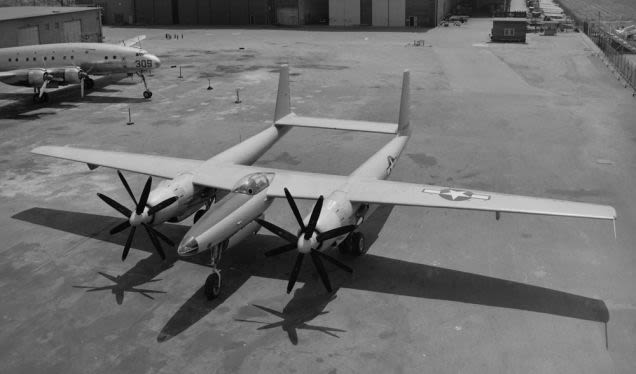
(US Air Force)
July 7, 1946 – The first flight of the Hughes XF-11, an experimental reconnaissance aircraft built for the US Army Air Corps by Howard Hughes to compete with the !!!error: Indecipherable SUB-paragraph formatting!!! for a US Army Air Forces contract. Resembling the !!!error: Indecipherable SUB-paragraph formatting!!! , the XF-11 was fitted with such a complex system of !!!error: Indecipherable SUB-paragraph formatting!!! , !!!error: Indecipherable SUB-paragraph formatting!!! propellers that the second prototype was fitted with traditional propellers. On its maiden flight, a hydraulic leak caused caused the loss of one engine, and Hughes crashed while attempting to make an emergency landing on a golf course, an accident that the Army attributed to pilot error. Hughes was seriously injured, but survived. After he recovered, Hughes successfully flew the second prototype in 1947, but the USAAF had lost interest in both the XF-11 and the XF-12, and both projects were canceled.
!!! UNKNOWN CONTENT TYPE !!!
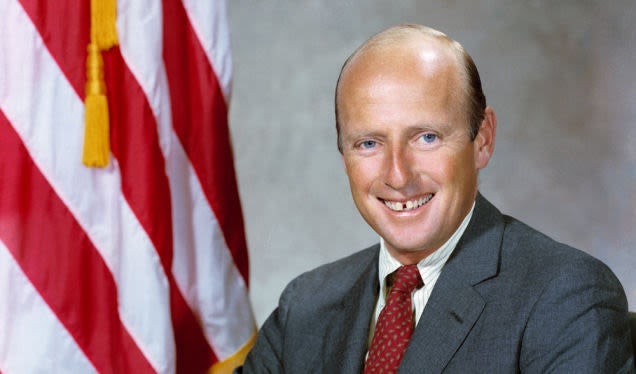
(NASA)
July 8, 1999 – The death of Charles “Pete” Conrad, a test pilot, aeronautical engineer, astronaut, and the third man to walk on the Moon. Born on June 1, 1930, Conrad began his astronaut career with NASA as a member of !!!error: Indecipherable SUB-paragraph formatting!!! , and flew alongside astronaut !!!error: Indecipherable SUB-paragraph formatting!!! on !!!error: Indecipherable SUB-paragraph formatting!!! on an eight-day mission orbiting the Earth that set an endurance record for the the time. Conrad followed Gemini 5 with the flight of !!!error: Indecipherable SUB-paragraph formatting!!! partnered with astronaut !!!error: Indecipherable SUB-paragraph formatting!!! . Conrad went to the Moon as mission commander on !!!error: Indecipherable SUB-paragraph formatting!!! , and also commanded !!!error: Indecipherable SUB-paragraph formatting!!! , the first manned mission to the !!!error: Indecipherable SUB-paragraph formatting!!! orbital space station. For Skylab 2, which carried out significant repairs to the space station, Conrad was awarded the !!!error: Indecipherable SUB-paragraph formatting!!! in 1978. After leaving NASA, Conrad worked in the television industry and with McDonnell Douglas, and was a member of a !!!error: Indecipherable SUB-paragraph formatting!!! crew that set a record for circumnavigating the globe in 49.5 hours in 1996.
!!! UNKNOWN CONTENT TYPE !!!
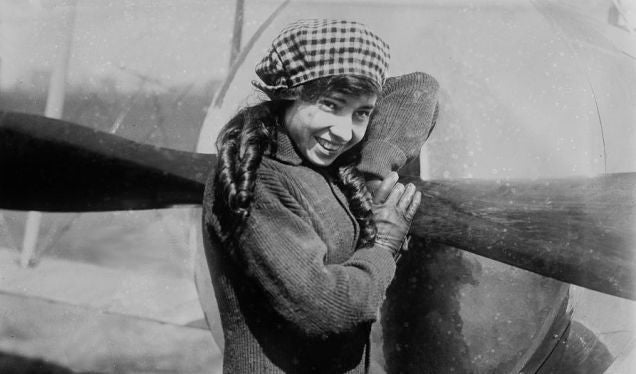
(US Library of Congress)
July 8, 1977 – The death of Katherine Stinson. Born on February 14, 1891, Stinson was the fourth woman in the US to obtain her pilot certificate, and soloed at the age of 21 after just four hours of instruction. The following year, she began touring on the flying exhibition circuit, where she was known as “The Flying Schoolgirl” and, in 1915, she became the first female pilot to perform a loop. In 1917, Stinson set an American record for non-stop flying when she completed a 606 mile flight from San Diego to San Francisco. During WWI, Stinson drove an ambulance in Europe, where she contracted influenza and was forced to give up flying. Her brothers, inspired by her aviation feats, started the !!!error: Indecipherable SUB-paragraph formatting!!! in 1920. Katherine Stinson was 86 at the time of her death.
!!! UNKNOWN CONTENT TYPE !!!
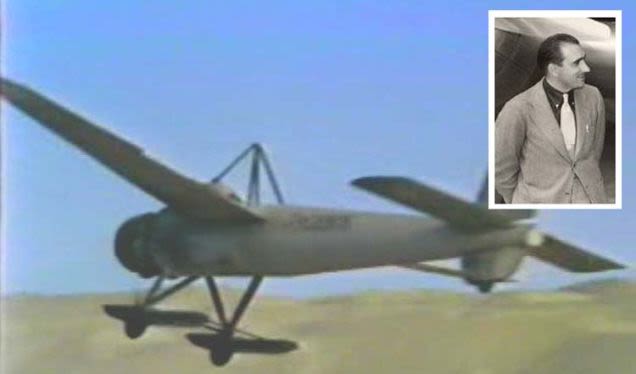
(Aircraft screenshot from The Flight of the Phoenix; Mantz photo public domain)
July 8, 1965 – The death of Paul Mantz.
Mantz was best known for his work as both an air racing pilot and movie stunt pilot then, after a stint as a commercial pilot, he went to work in Hollywood. He worked for
!!!error: Indecipherable SUB-paragraph formatting!!!
and others, and made his film debut flying a
!!!error: Indecipherable SUB-paragraph formatting!!!
biplane in the 1932 film
!!!error: Indecipherable SUB-paragraph formatting!!!
. During WWII, Mantz served in the
!!!error: Indecipherable SUB-paragraph formatting!!!
and took up racing after the war, winning the
!!!error: Indecipherable SUB-paragraph formatting!!!
in three consecutive years. Returning to his movie career, Mantz was hired to fly the
!!!error: Indecipherable SUB-paragraph formatting!!!
, a highly modified aircraft that was meant to represent a jury-built aircraft flown out of the desert by a marooned aircrew in
!!!error: Indecipherable SUB-paragraph formatting!!!
.
During filming, Mantz carried out a particularly aggressive maneuver and the plane broke apart, killing him. The FAA investigation cited alcohol consumption as a factor in the crash, though others dispute that finding.
!!! UNKNOWN CONTENT TYPE !!!
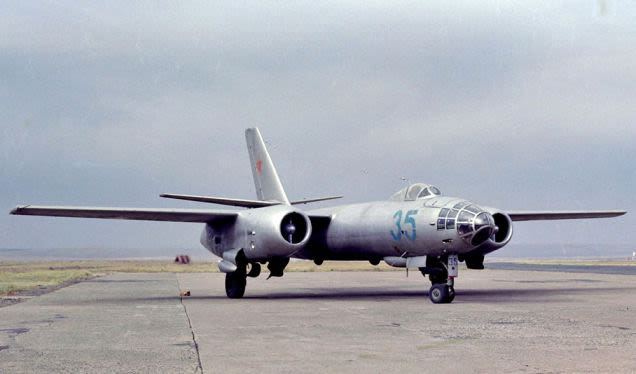
(Author unknown)
July 8, 1948 – The first flight of the Ilyushin Il-28, an early postwar twin-engine bomber produced for the Soviet Air Force and the first jet-powered Soviet bomber to enter large scale production. Ilyushin developed the Il-28 (NATO reporting name Beagle) first using !!!error: Indecipherable SUB-paragraph formatting!!! turbojet engines purchased from Britain, and then used reverse engineered copies designated the !!!error: Indecipherable SUB-paragraph formatting!!! . The Il-28 had a top speed of 560 mph and could carry up to 6,600 pounds of bombs. It was also fitted with four cannons, two in the nose and two in the tail for defense. A total of 6,635 were produced, with just under 200 converted to two-seat trainers. The Il-28 was widely exported, and was also built under license in China as the Harbin H-5. The Soviets retired the Il-28 in the 1980s, though some remained in service into the 1990s.
!!! UNKNOWN CONTENT TYPE !!!
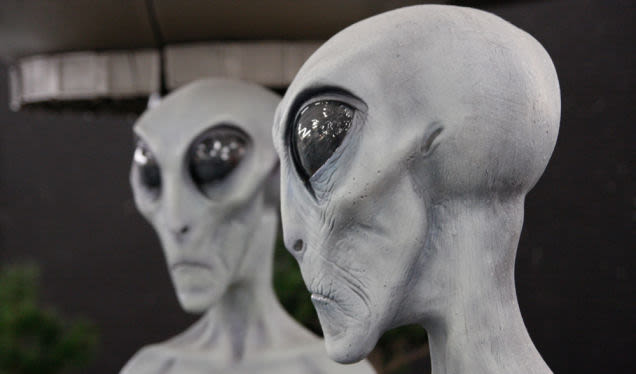
(Tim Shaffer)
July 8, 1947 – The Roswell Daily Record reports that a UFO crash landed near Roswell, New Mexico. The UFO craze traces its roots to rural New Mexico when a farmer near Roswell found pieces of what he believed was an alien spacecraft, and the local newspaper !!!error: Indecipherable SUB-paragraph formatting!!! announcing the capture of a “flying saucer.” The US military arrived, quickly took the wreckage away, and told local residents that it was debris from a crashed weather balloon, fueling theories of a government cover up. Recently released documents now explain that the debris was actually part of !!!error: Indecipherable SUB-paragraph formatting!!! , a balloon that carried secret listening devices to detect Soviet nuclear tests. Other reports that actual aliens had been found in the wreck are most likely due to the discovery of weighted mannequins that were dropped from Air Force planes to test the the effects of high-altitude ejections from aircraft.
!!! UNKNOWN CONTENT TYPE !!!
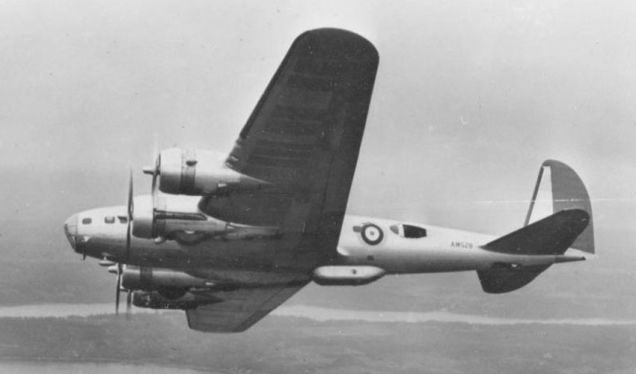
(US Air Force)
July 8, 1941 – The Boeing B-17 Flying Fortress flies its first combat mission of WWII. The !!!error: Indecipherable SUB-paragraph formatting!!! was the iconic American heavy strategic bomber in the airwar over Europe, but despite its association with the US Army Air Corps (USAAC) and later US Army Air Forces (USAAF), the Flying Fortress first flew into battle in the hands of Royal Air Force pilots in 1941 before the US became involved in the war. When war broke out in Europe, England did not yet have a heavy bomber of its own. So the USAAC provided them with 20 B-17Cs (the RAF designated it the Fortress I), and the bomber saw its first action of the war in an unsuccessful raid against the German port at Wilhelmshaven. The B-17 never really caught on with the RAF and, after losing eight of their initial fleet, the remaining bombers were shifted to Coastal Command for use in maritime patrol.
!!! UNKNOWN CONTENT TYPE !!!
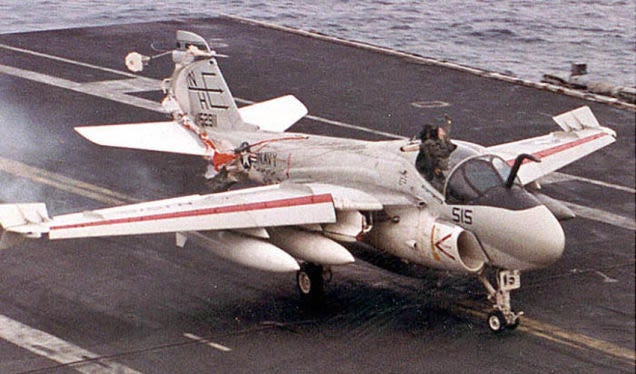
(US Navy)
July 9, 1991 – Bombardier-Navigator Lt. Keith Gallagher experiences partial ejection from a US Navy Grumman KA-6D Intruder.
While flying from the carrier
!!!error: Indecipherable SUB-paragraph formatting!!!
!!!error: Indecipherable SUB-paragraph formatting!!!
(CVN-72), a malfunction of Gallagher’s ejection seat caused him to be partially ejected through the canopy of his
!!!error: Indecipherable SUB-paragraph formatting!!!
(the aerial tanker version of the Navy attack plane). As the aircraft flew at 264 mph, Gallagher found himself stuck in the broken canopy, his arms flailing in the gale outside the aircraft. His helmet and air mask were ripped off, and he could not breathe because of the wind blasting into his face. Pilot Lt. Mark Baden declared an emergency and was immediately routed back to the carrier, where he landed safely, with Gallagher still sticking out of the cockpit. Miraculously, Gallagher was still alive. He suffered paralysis in half of his right arm, and damage to his left shoulder, as well as significant facial injuries. After six months of recovery, Gallagher returned to service.
A full account of the incident can be read
!!!error: Indecipherable SUB-paragraph formatting!!!
.
!!! UNKNOWN CONTENT TYPE !!!

(US Navy)
July 10, 2013 – The Northrop Grumman X-47B unmanned combat air vehicle lands aboard USS George Washington (CVN 73). In 2000, the US Navy committed to the development of an Unmanned Combat Air System (UCAS) and awarded contracts for demonstrator aircraft to Boeing and Northrop Grumman. Following its first launch from the !!!error: Indecipherable SUB-paragraph formatting!!! (CVN 77) on May 14, 2013, the X-47B performed the first autonomous touch-and-go landings three days later and the first arrested carrier landing on July 10. The X-47B also demonstrated autonomous aerial refueling in April of 2015. The X-47 program was followed by development of a !!!error: Indecipherable SUB-paragraph formatting!!! (UCLASS), though the Navy is now focusing on an unmanned aerial refueling system with the MQ-25 Stingray.
!!! UNKNOWN CONTENT TYPE !!!
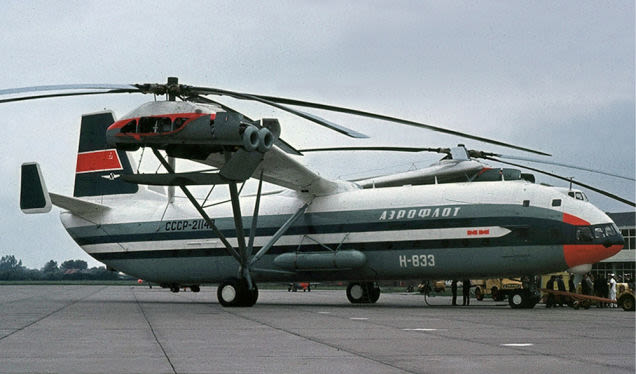 !!!CAPTION ERROR: MAY BE MULTI-LINE OR CONTAIN LINK!!!
!!!CAPTION ERROR: MAY BE MULTI-LINE OR CONTAIN LINK!!!
July 10, 1968 – The first flight of the Mil V-12, a twin-rotor helicopter capable of lifting up to 88,000 pounds and the largest helicopter in the world. After experimenting with a tandem rotor system similar to the !!!error: Indecipherable SUB-paragraph formatting!!! , Mil settled on a transverse system of rotors that eliminated the need for a tail rotor. Power is provided by a pair of !!!error: Indecipherable SUB-paragraph formatting!!! turboshaft engines that give the V-12 a top speed of 162 mph. Two aircraft were built, and they set eight world records, four of which still stand today. However, by the time the aircraft was ready for production the Soviet Air Force decided that they no longer needed the gargantuan helicopter and it was never put into serial production.
!!! UNKNOWN CONTENT TYPE !!!

(Engineering & Technology Magazine)
July 10, 1962 – Launch of Telstar 1. The !!!error: Indecipherable SUB-paragraph formatting!!! between the United States and the Soviet Union during the !!!error: Indecipherable SUB-paragraph formatting!!! began when the Russians launched their !!!error: Indecipherable SUB-paragraph formatting!!! satellite into Earth orbit on October 4, 1957. The earliest satellites simply sent electronic signals back to the ground, but Telstar 1 was the first truly utilitarian communications satellite and the first capable of relaying television pictures, telephone calls and facsimile images. It also transmitted the first live television images across the Atlantic Ocean. Built by a consortium of telecom companies, Telstar 1 was launched from !!!error: Indecipherable SUB-paragraph formatting!!! atop a !!!error: Indecipherable SUB-paragraph formatting!!! rocket and beamed its first images back to Earth the following day. A total of 18 Telstar satellites of increasing capability were launched by 2004, and the last is expected to function beyond its designed 13 years.
!!! UNKNOWN CONTENT TYPE !!!
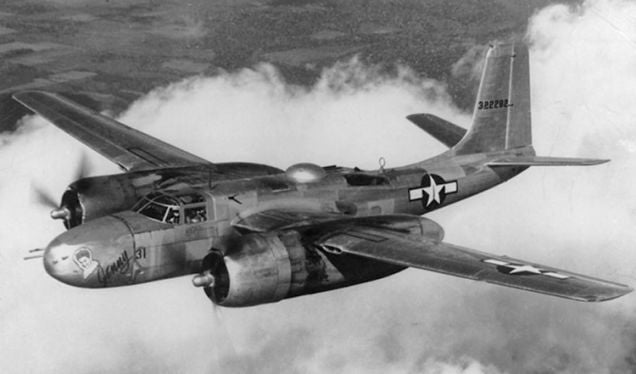
(US Air Force)
July 10, 1942 – The first flight of the Douglas A-26 Invader, a fast, powerful attack aircraft designed as a successor to the !!!error: Indecipherable SUB-paragraph formatting!!! and one that was unusual for having a single pilot for a plane of its size. The right seat was occupied by a navigator/loader. The A-26 featured a !!!error: Indecipherable SUB-paragraph formatting!!! wing and was powered by a pair of !!!error: Indecipherable SUB-paragraph formatting!!! radial engines which allowed the Invader to carry up to 6,000 pounds of bombs. It was produced in two main versions: one with a plexiglass nose housing a !!!error: Indecipherable SUB-paragraph formatting!!! for traditional bombing missions, and a second with a solid nose armed with up to eight .50 caliber machine guns. Later versions mounted an additional six machine guns in the wings, for a total of 14 forward-firing guns. Delivery of the Invader to the Pacific began in August 1943, then to Europe the following year, where it flew over 11,000 sorties and dropped over 18,000 tons of bombs. After WWII, the Invader saw service in Korea and Vietnam, plus numerous other Cold War conflicts. Almost 2,500 A-26s were produced, and it served until 1980 with the Colombian Air Force.
!!! UNKNOWN CONTENT TYPE !!!
Connecting Flights
!!! UNKNOWN CONTENT TYPE !!!
!!! UNKNOWN CONTENT TYPE !!!
!!! UNKNOWN CONTENT TYPE !!!
!!! UNKNOWN CONTENT TYPE !!!
!!! UNKNOWN CONTENT TYPE !!!
If you enjoy these Aviation History posts, please let me know in the comments. And if you missed any of the past articles, you can find them all at
!!!error: Indecipherable SUB-paragraph formatting!!!
. You can also find more stories about aviation, aviators and airplane oddities at
!!!error: Indecipherable SUB-paragraph formatting!!!
.
!!! UNKNOWN CONTENT TYPE !!!
 For Sweden
> ttyymmnn
For Sweden
> ttyymmnn
07/10/2018 at 12:45 |
|
Telstar: Because surface area is unimportant for both solar power generation and heat dissipation .
 user314
> ttyymmnn
user314
> ttyymmnn
07/10/2018 at 12:50 |
|
Obligatory:
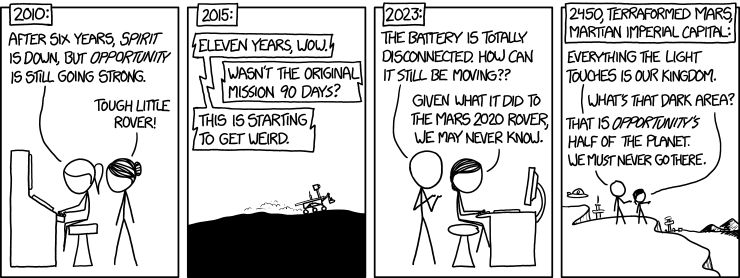
 facw
> ttyymmnn
facw
> ttyymmnn
07/10/2018 at 12:56 |
|
Seems worth mentioning that Opportunity is currently in at most risk as it has been in on time in Mars. It has had to go into an extreme low power mode due to a huge (nearly planet-wide) dust storm on Mars. Last I read there was some concern that it would not have enough power for its heaters through the whole event, but scientists were optimistic that the storm itself would provide enough insulation that it wouldn’t die without heat. I believe the storm is finally supposed to be dissipating, so hopefully Opportunity will be able to get enough power to wake up and call home. There is some risk that the storm will leave too much dust on Opportunity’s solar panels as well, but past storms have generally knocked more dust off the panels than they deposited, so that may not be an issue.
Curiosity has been subject to the same storm, but it is less intense where C uriosity is, and Curiosity is not solar powered, so it hasn’t been as much of an issue. Curiosity took this selfie (actually a composite to keep its arm out of the shot) as the storm was picking up in June:

 RamblinRover Luxury-Yacht
> ttyymmnn
RamblinRover Luxury-Yacht
> ttyymmnn
07/10/2018 at 13:30 |
|

 3point8isgreat
> ttyymmnn
3point8isgreat
> ttyymmnn
07/11/2018 at 15:45 |
|
The Atlantis display at Kennedy is pretty awesome, and actually what my profile picture is of!
The whole introduction they have you go through, while kind of cheesy, gives me goosebumps every time.